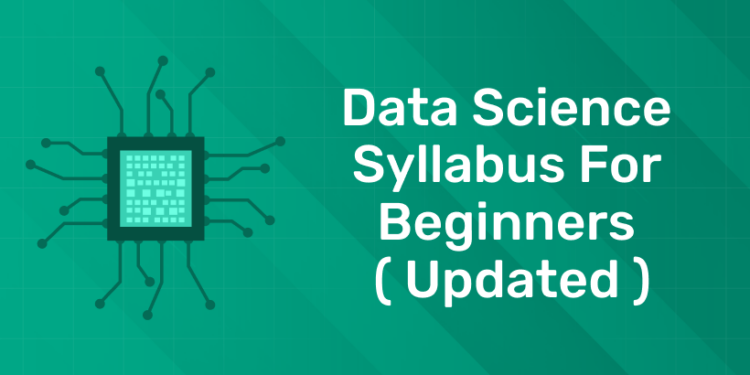Table of Contents
Data Science syllabus will cover a wide range of topics in statistics, math, and IT. In a beginner’s course, you will learn both basic and advanced concepts in data analytics, machine learning, and statistics. Mostly, languages like Python or R are used. You will also learn to analyze large datasets, find patterns, and create predictive models. In this article we will explore the data science syllabus for beginners.
Ready to take your data science skills to the next level? Sign up for a free demo today!
Why Data Science?
1. High Demand for Data Science Careers
- Job Opportunities
- Data science careers are highly sought after.
- Numerous industries need skilled data scientists.
- Career Security
- No shortage of opportunities in data science.
- Diverse Industry Needs
- Almost every sector requires data science expertise.
2. Strong Employment Outcomes
- Successful Graduates
- 100% employment rate within six months of graduation.
- Career Advancements
- Graduates receive promotions and lucrative job offers.
- Decision-Making Roles
- Opportunities to join strategic teams.
3. Low Supply of Skilled Workers
- Skill Shortage
- Many positions available but few qualified candidates.
- Competitive Edge
- Skills in storytelling, quantitative analysis, and computation.
- Effective communication and ethical behavior are key.
4. Versatility and Broad Applicability
- Flexible Field
- Applicable in various industries like banking, education, and marketing.
- Wide Application
- Helps organizations make better decisions and achieve goals faster.
- Industry Opportunities
- Find roles that match your career interests and values.
5. Potential for Lasting Impact
- Valuable Insights
- Compile, analyze, and extract data insights.
- Powerful Applications
- Detect early-stage tumors, optimize routes, improve sports performance, detect fraud.
- Meaningful Contributions
- Make significant improvements and innovations in various fields.
Future Scope of Data Scientist
1. Foundation for AI and Automation
- Core of AI and Machine Learning
- Data Science underpins AI and machine learning technologies.
- Increased Employability
- The growth of automation (robots, chatbots, virtual assistants) boosts demand for data scientists.
2. Growing Job Market
- High Demand
- Data Science is a trending skill in the job market.
- Significant Growth
- IBM reports a projected 30% growth in Data Science jobs.
- Estimated 2,720,000 job listings for Data Science by 2024.
- Long-term Outlook
- US Bureau of Labor Statistics predicts 11 million jobs by 2026.
3. Business Optimization
- Profit Maximization
- Businesses use Data Science to optimize profits.
- Industry Demand
- Every industry needs data scientists to manage and analyze data for better decision-making.
4. Data Volume Explosion
- Massive Data Management
- Organizations handle zettabytes of data.
- Rising Data Volumes
- The amount of data will keep growing, increasing demand for data science professionals.
5. Top Data Science Jobs
- Key Positions
- Data Scientist
- Data Analyst
- Data Engineer
- Business Analyst
6. Opportunities in Various Sectors
- Diverse Sectors
- Data Science jobs are expanding in both government and private sectors worldwide.
- New Career Paths
- Data opens numerous opportunities for data scientists across different industries.
7. Future Scope in Different Job Sectors
Healthcare
- Role of Data Science: Tracks patient health, helps doctors understand disease patterns, and aids in disease prevention.
- Need for Data Engineers: To develop automated systems for analyzing complex clinical data.
- Benefits:
- Improved patient care
- Faster and more accurate diagnoses
- Preventative measures
- Individualized treatment
- Informed decision-making
- Job Growth: Expected to create 20,000 jobs by 2024.
Aviation and Airlines
- Role of Data Science: Used for pricing strategies, route optimization, and preemptive maintenance.
- Data Analysis: Involves route distance, altitude, aircraft type, weight, weather, and passenger behavior.
- Benefits: Enhances passenger services and operational efficiency.
- Job Growth: Expected to create over 3,000 new jobs in 2024.
Cyber Security
- Role of Data Science: Detects and prevents fraudulent activities due to increased online transactions.
- Techniques:
- Machine learning for pattern recognition
- Developing algorithms to protect data
- Benefits:
- Manages large data sets
- Provides effective solutions against digital threats
- Job Growth: Expected to create over 5,000 jobs in 2024.
Genomics
- Role of Data Science: Studies DNA sequences, functions, mapping, structure, and evolution.
- Impact: Leads to significant advancements in medical sciences.
- Job Growth: Expected to create numerous jobs in 2024.
Automotive
- Role of Data Science: Essential for developing driverless and eco-friendly vehicles.
- Need for Experts: High demand for data science skills in manufacturing automated vehicles.
- Job Growth: Expected to grow up to 25,000 jobs by 2024.
Software Development
- Role of Data Science: Commonly used to build automated software development tools.
- Industry Demand: High demand for data science professionals.
- Job Growth: Expected to create up to 100,000 jobs by 2024.
E-commerce
- Role of Data Science: Enhances customer service and user experience through data analysis.
- Industry Scope: There are approximately 273,000 e-commerce companies globally.
Ready to take your data science skills to the next level? Sign up for a free demo today!
Key Skills For Data Scientists
Technical Skills for a Data Science Career
To become a data scientist, you need to develop several key technical skills.
Programming Languages
Programming is essential for data scientists to communicate with computers. Here are some important languages to learn:
1. Python
- Versatile Use: Used in data science, web development, and more.
- Key Libraries:
- Pandas: For database manipulation.
- NumPy: For array operations.
- Matplotlib: For data visualization.
- Learning Resources: Many beginner courses available.
2. R
- Data Science Focus: Designed for statistical computing, machine learning, and data visualization.
- Popular: Widely used in data science, second to Python.
- Community Support: Large user community with useful libraries like Tidyverse.
- Learning Resources: Look for R-specific courses.
3. SQL
- Database Interaction: Used to manage and query relational databases.
- Complementary: Works alongside Python and R.
- Easy to Learn: Simple syntax, widely taught.
- Learning Resources: Courses from IBM, Google, and universities.
Mathematics, Statistical Analysis, and Probability
1. Mathematical Foundation
- Calculus and Algebra
- Fundamental mathematical concepts used in data science.
- Probability and Statistics
- Crucial for analyzing data and making predictions.
2. Data Science Mathematics Courses
- Building on Strong Foundation
- Utilize existing high school mathematics knowledge.
- Online Courses on Platforms like Coursera
- Provide structured learning and deep understanding.
Data Mining
1. Gathering and Analyzing Data
- Definition
- Involves sorting, analyzing, and extracting insights from large datasets.
- Techniques
- Linear regression analysis, clustering analysis, and anomaly detection.
2. Importance in Data Science
- Indeterminate Data Scientist Skill
- Often taught within comprehensive career-focused courses.
Machine Learning and AI
1. Basic Concepts
- Machine Learning, Deep Learning, and AI
- Separate specializations but overlap in application.
2. Utilization in Data Science
- Training Machine Learning Models
- Using data science to provide data for training algorithms.
- Models Used
- Decision trees, predictive models, and others.
Familiarity With Hadoop
1. Definition and Purpose
- Open-Source Framework
- Enables efficient processing of large datasets across multiple computers.
2. Importance for Data Scientists
- Efficient Handling of Large Datasets
- Particularly valuable for data scientists dealing with extensive data.
Data Visualization
1. Importance of Visual Representation
- Communicating Insights
- Turning data into comprehensible visualizations like charts and graphs.
2. Tools and Techniques
- Visualization Tools
- Python libraries, software like Tableau.
- Presentation Skills
- Essential for conveying insights effectively.
Business Strategy
1. Understanding Stakeholder Needs
- Essential for Unearthing Useful Insights
- Insights should align with business objectives and decision-making processes.
2. Skill Development
- Taught in Data Science Bootcamps
- Provides understanding of business strategy and stakeholder requirements.
Cloud Computing
1. Interaction with Big Data
- Storage and Processing
- Big data typically stored and processed through cloud computing.
2. Importance for Data Scientists
- Basic Understanding
- Facilitates interaction with cloud-based data storage systems.
Soft Skills for a Data Science Career
1. Communication
- Clear Communication: Building relationships and gathering information efficiently.
- Group Projects: Joining group projects to improve communication skills.
2. Analytical Mindset
- Objective Thinking: Approaching problems objectively for accurate analysis.
- Critical Thinking: Ensuring unbiased work through critical analysis.
3. “Out-of-the-Box” Thinking
- Framing Questions: Identifying the right questions and solutions.
- Creative Thinking: Innovatively uncovering new insights.
4. Decision Making
- Independence: Working autonomously to provide insights.
- Problem Solving: Making informed decisions based on data analysis.
5. Collaboration
- Teamwork: Utilizing input from colleagues for better outcomes.
- Interpersonal Skills: Learning to listen and collaborate effectively.
6. Storytelling
- Presentation Skills: Persuasively presenting data to non-technical stakeholders.
- Data Visualization: Using visuals to create clear narratives.
7. Attention to Detail
- Thorough Analysis: Exploring possibilities with attention to detail.
- Accuracy: Ensuring reliability through meticulous work.
8. Continuous Learning
- Adaptability: Keeping up with evolving trends in data science.
- Professional Growth: Committing to ongoing learning and skill development.
How to Become a Data Scientist
1. Learn Fundamental Skills
- Master data wrangling, visualization, and reporting.
- Understand statistics, math, and machine learning basics.
2. Develop Programming Skills
- Learn Python, R, and SQL for data manipulation and analysis.
- Understand databases and how to query structured data.
3. Familiarize with Big Data Technologies
- Explore cloud platforms like AWS, Azure, and Google Cloud.
- Learn tools like Apache Spark for big data processing.
4. Gain Practical Experience
- Work on real-world projects to apply your skills.
- Engage with data science communities for networking and collaboration.
5. Pursue Internships or Entry-level Jobs
- Apply for internships or roles to gain professional experience.
- Build a portfolio and prepare for interviews.
6. Stay Updated and Engage with the Community
- Keep learning about industry developments and trends.
- Connect with data science professionals on social media platforms.
Educational Paths
- Take online courses and certifications from platforms like DataCamp.
- Pursue a bachelor’s or master’s degree in data science, computer science, or related fields.
- Consider data science bootcamps for intensive training and practical skills acquisition.
Data Science Syllabus for Beginners
-
Introduction to Data Science
- Basics of data science and its applications.
- Understanding different types of data.
-
Exploratory Data Analysis
- Techniques for exploring and understanding datasets.
- Using descriptive statistics and data visualization.
-
Machine Learning
- Introduction to machine learning algorithms.
- Learning about supervised, unsupervised, and reinforcement learning.
-
Model Selection and Evaluation
- Methods for choosing and assessing machine learning models.
- Understanding cross-validation and performance metrics.
-
Data Warehousing
- Principles of data warehousing and ETL processes.
- Basics of data modeling.
-
Data Mining
- Extracting patterns and insights from data.
- Learning about association rule mining, clustering, and classification.
-
Data Visualization
- Creating effective visualizations to represent data.
- Using tools and libraries for visualization.
-
Cloud Computing
- Introduction to cloud platforms for data storage and analysis.
- Understanding the benefits of cloud computing.
-
Business Intelligence
- Using data for decision-making in business.
- Analyzing business data and generating insights.
-
Storytelling with Data
- Communicating insights through storytelling.
- Creating compelling narratives with data.
-
Communication and Presentation
- Strategies for effectively communicating data-driven insights.
- Presentation skills for different audiences.
Conclusion
Frequently Asked Questions
What does the Data Science syllabus cover for beginners?
The syllabus covers foundational topics such as data analysis, machine learning, and data visualization.
Are there any prerequisites for beginners to start the syllabus?
No specific prerequisites are required, but basic computer literacy and an interest in data science are beneficial.
How can beginners access the syllabus?
Beginners can access the syllabus through online platforms offering introductory data science courses.










![Full-Stack Developer Interview Questions for Freshers [2024]](https://entri.app/blog/wp-content/uploads/2024/05/Full-Stack-Developer-Interview-Questions-75x75.webp)
